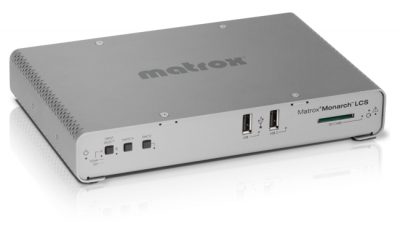Why You Need the Matrox Monarch LCS
By Jim Bask
From RedShark News
Matrox takes the pain out of lecture recording

The Monarch LCS is networkable and ready for action as soon as you take it out of the box and connect to your establishment’s network.
Configuring the device couldn’t be easier. As soon as you attach to your network, the device presents you with an IP address. Key this into your browser and the command centre (a simple three-page intuitive UI) pops up, is ready to be configured, and you’re ready to go.
There are straightforward drop down menus for ease of selection with enough choice to cover very low rate streaming all the way up to HD recording. And layout picture options that you simply click on, to choose how the video will be viewed.
Within the Save/Load page, there is a drop down menu for ‘Profiles’ allowing multiple lecturers/teachers to save their individual settings for their lectures and hardware negating the need to set up each time they want to stream or record a lecture.
The device comes with a choice of modes to suit most, if not all, student viewing requirements, the most powerful of these being the dual isolated mode. This allows the student to view using multi-stream players where they can effectively choose their own viewing mode; fantastic if, as a student, you need to concentrate on a particular element or section of the lecture.
It includes dual inputs/outputs H.264 encoding for video through HDMI and SDI for any establishments that may have broadcast standard equipment at their disposal. There is also a HDMI input for computers (for lecture content/presentations) as well as analog audio in and out.
This is a dual channel device, which can be run as single or dual channel, and can be configured to stream on both channels, record on both channels (or one of each at the same time) or solo. Great if you want to livestream at a lower bit rate but record at a higher bit rate so as to make the recording available later for VOD, or stream to two different streaming platforms that have different streaming rates.

